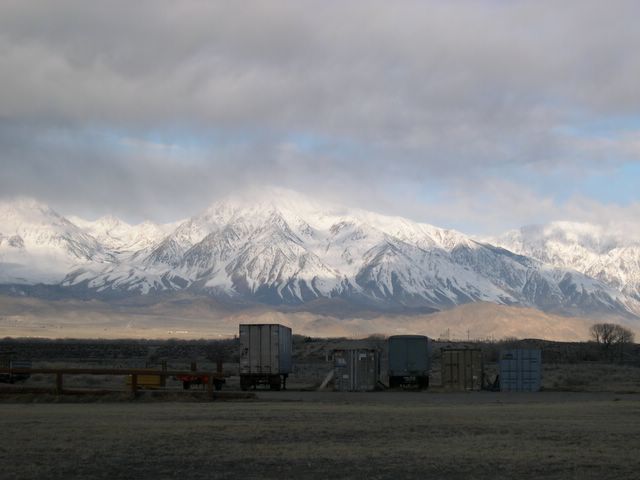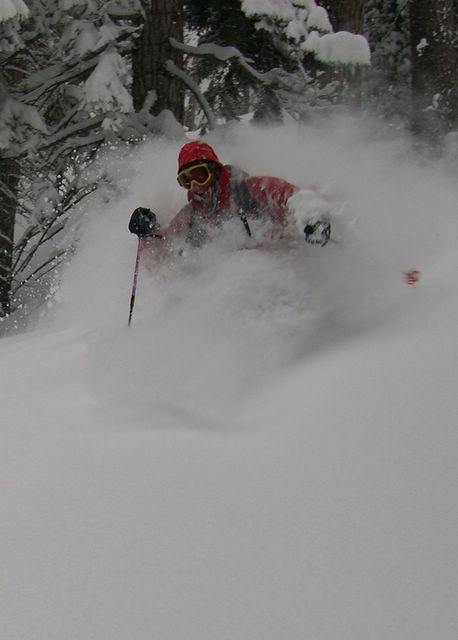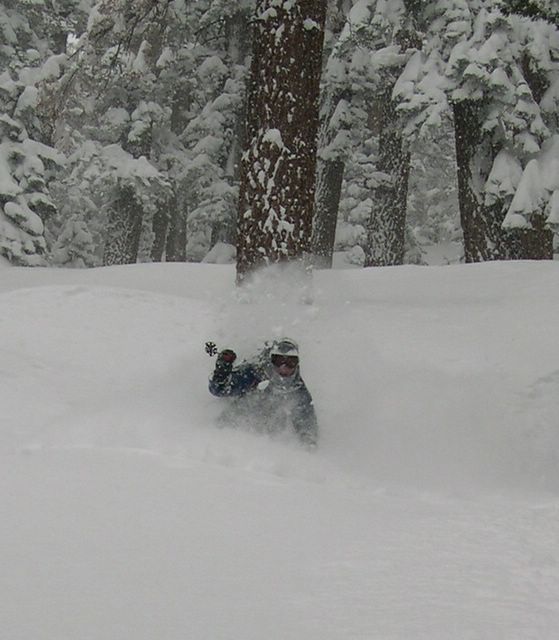I had my first Pear Lake Hut experience this past weekend. As I promised everyone who I went there with, I'm going to start off by saying that it was a terrible place, with terrible snow, and 2 terrible caretakers who will stop at nothing to make your stay there miserable. So if you don't get the point, DON'T GO TO THE PEAR LAKE HUT! Its not worth the 5 hour slog it takes to get there. Now if you've already decided not go there, please stop reading this article and never again come back to my blog. For those of you who want to hear all the details of my terrible Pear Lake Hut experience, keep reading.

This was my first time out on a backcountry trip that was longer than a day. To be honest, even though it was only a hut trip, I did have some anxiety about it throughout the week. Despite Nellie (see Wolverine man article) having sent out a good packing list, I still really didn't know what I would need. How much food was I going to go through each day? How many changes of clothing would I need? I didn't know. I wasn't sure whether to bring a full-sized backpack or to go with a daypack and attach stuff sacks to it. I decided to go with stuff sack option and packed a ton of food and twice as much clothing as I needed.
We set off from the Wolverton parking lot (at Sequoia National Park) on Friday morning. The weather was great. It was sunny and mid 40's. We followed the Pear Lake Trail up to the top of the hump. I had taken a portion of this trail before to go up to ski 9975. But the trail is much more challenging with a 40 lb pack on your back. From the hump you follow the trail down to Heather Lake and then follow the yellow triangles to the hut.
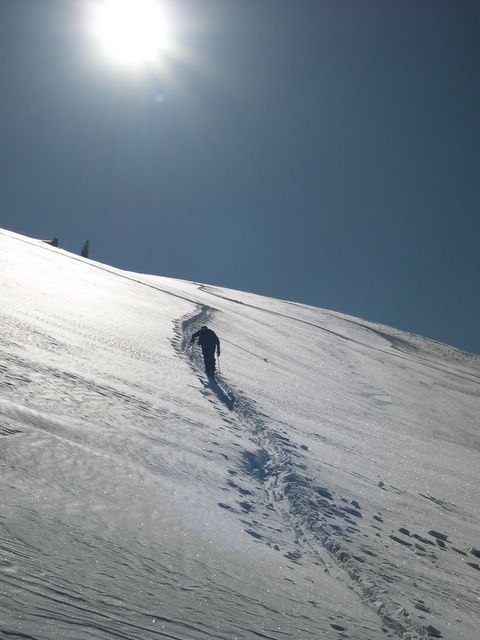 As much as I love skinning and the whole being out in nature thing, I go backcountry skiing so I can get good turns in. So while most of the party kept moving towards the hut, John, Tyler, and I made a short excursion up to the Soccer Fields (Just past Heather Lake and above the trail to the right). It was heavenly. The skin track was already in place. Apart from 2 sets of tracks from the previous group at the hut, we were making fresh tracks all the way down. We had about 8" of nice creamy powder. The runs started out as a wide open low grade bowl (~500' vert) and finished up with about 300' vertical through steeper terrain with some trees and rocks. It wasn't Utah light. But it was pretty damned good. After one run on the Soccer Fields, we left to join up with the others. We were giddy with the knowledge of just how good this weekend was going to be.
As much as I love skinning and the whole being out in nature thing, I go backcountry skiing so I can get good turns in. So while most of the party kept moving towards the hut, John, Tyler, and I made a short excursion up to the Soccer Fields (Just past Heather Lake and above the trail to the right). It was heavenly. The skin track was already in place. Apart from 2 sets of tracks from the previous group at the hut, we were making fresh tracks all the way down. We had about 8" of nice creamy powder. The runs started out as a wide open low grade bowl (~500' vert) and finished up with about 300' vertical through steeper terrain with some trees and rocks. It wasn't Utah light. But it was pretty damned good. After one run on the Soccer Fields, we left to join up with the others. We were giddy with the knowledge of just how good this weekend was going to be.
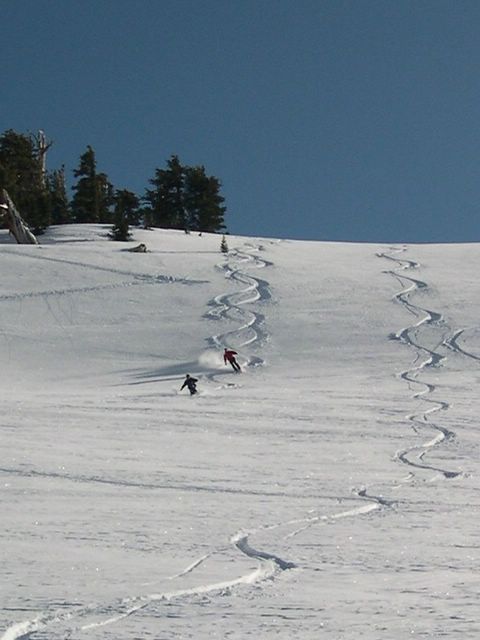
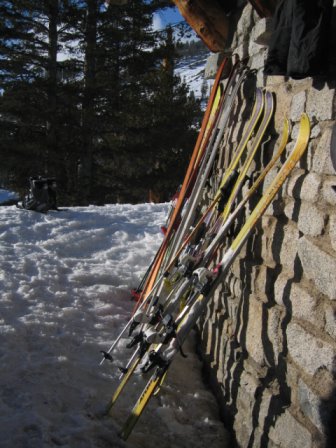 After another hour on the trail, we arrived at the hut. If you're expecting luxury accommodations, you're going to be disappointed. It’s definitely not a luxury condo in Vail. Its basically one big common room that is used for eating, socializing, and sleeping. Besides beds (with mattresses), it’s main amenities are an indoor toilet, a wood pellet stove for heat, solar powered lights to use at night, and two Coleman propane stoves to cook on. For a complete list of what the hut has and what they recommend that you bring, see the website. (http://www.sequoiahistory.org/pearlake/pearlakehutequip.htm).
After another hour on the trail, we arrived at the hut. If you're expecting luxury accommodations, you're going to be disappointed. It’s definitely not a luxury condo in Vail. Its basically one big common room that is used for eating, socializing, and sleeping. Besides beds (with mattresses), it’s main amenities are an indoor toilet, a wood pellet stove for heat, solar powered lights to use at night, and two Coleman propane stoves to cook on. For a complete list of what the hut has and what they recommend that you bring, see the website. (http://www.sequoiahistory.org/pearlake/pearlakehutequip.htm).
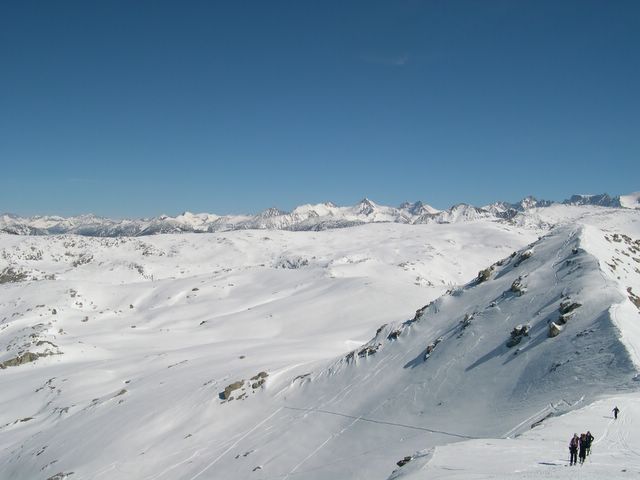 On Saturday, we left the hut at 9 AM to head up to the top of Skier's Alta (north facing portion of Alta peak that you ski from the hut). It was another gorgeous day…sunny and high 30's. It was 2000 vertical feet from the hut to the top of Skier's Alta and it took us 1 hr 45 minutes to make it up. On the way up, Miles, Evan and I were all salivating over some of the chutes that hadn't been skied since the last storm. We settled on skiing the Hourglass Chutes for our first run. It was about 500' vertical and true to its name, it was wide open at the top and bottom with a bottleneck in the middle. I was the 3rd one into the chute. Apart from some wind pack at the top, it was great skiing. From the bottleneck to the bottom, it was steep (30-35 degrees?) with about 8-10" of great, untouched powder. After getting to the bottom and looking up to see our turns, it really did look like a scene out of a heli-skiing video.
On Saturday, we left the hut at 9 AM to head up to the top of Skier's Alta (north facing portion of Alta peak that you ski from the hut). It was another gorgeous day…sunny and high 30's. It was 2000 vertical feet from the hut to the top of Skier's Alta and it took us 1 hr 45 minutes to make it up. On the way up, Miles, Evan and I were all salivating over some of the chutes that hadn't been skied since the last storm. We settled on skiing the Hourglass Chutes for our first run. It was about 500' vertical and true to its name, it was wide open at the top and bottom with a bottleneck in the middle. I was the 3rd one into the chute. Apart from some wind pack at the top, it was great skiing. From the bottleneck to the bottom, it was steep (30-35 degrees?) with about 8-10" of great, untouched powder. After getting to the bottom and looking up to see our turns, it really did look like a scene out of a heli-skiing video.
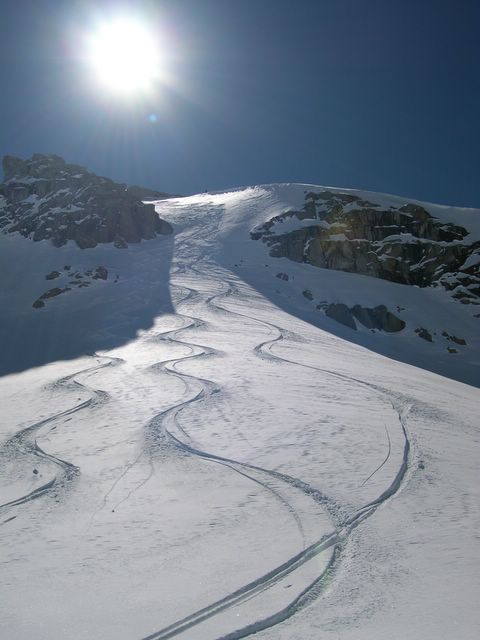
The rest of the way down is composed of two wide-open bowls, one above the other. The first bowl is definitely low grade while the second one is a bit steeper. The snow on both was excellent. After getting to the bottom we stopped for lunch. At that point, John, Nat, and I decided to head on over to Pear Lake and check out Milo's Couloir to see if it was skiable. Unfortunately, when we got to it, we found that due to its more easterly exposure, it had crusted over and wouldn’t be any good.
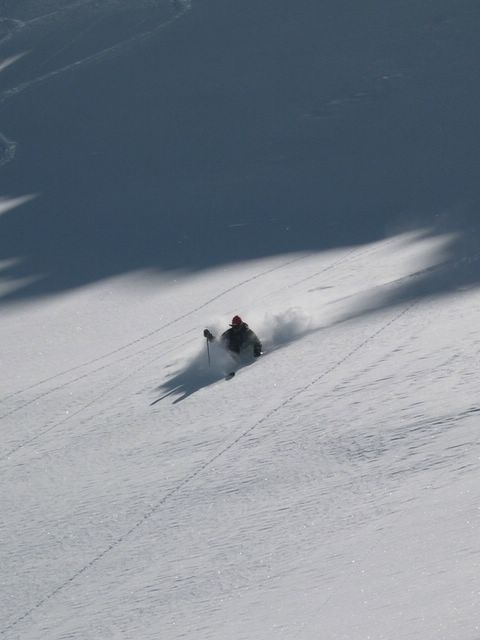
Just when we were skiing back from the base of the couloir to the lake, I literally fell through a hole in the snow. Everything below my arms had broken through and I was held up by bracing my back and skis against the sides of the hole. Looking down into it, it was at least 10 feet deep below me. Luckily for me, John was still above me when I fell in and was able to pull me out. It was one of the only times in recent memory that I have truly been scared while on skis. If I had fallen in, I would have been there until they could have come back with ropes to pull me out. Thankfully I wasn't by myself that day.
After that adventure, we skinned up a short, more northerly section of the same ridge. Unfortunately Miles and Evan deemed the snow pack to be too slabby to try and ski the main face. So we skied back down to the lake following our skin track. I didn’t see it, but I was told that Nat had a nice collision with a tree on the way down. John and I finished out the day with another run 2/3 of the way up Skier's Alta. It was every bit as good as the first.
 Besides great skiing, we also ate and drank well at the hut. When we got back, we found a full vat of River 'Ritas (Beer, lime-aid, and tequila) waiting for us. Earlier in the entry I know I sounded like I was complaining about all the weight we were carrying in. Well, I now admit that it was our own doing. That's what you get when you bring in enough booze (several 12 packs of beers, 2 bags o' wine, and a few bottle of whiskey) and food to insure that despite burning several thousand calories greater than normal per day, you come back 10 lbs heavier. It didn't hurt that all the meals from Chris's heavenly pasta to Kinga and Dave's Rice and Chili were absolutely delicious.
Besides great skiing, we also ate and drank well at the hut. When we got back, we found a full vat of River 'Ritas (Beer, lime-aid, and tequila) waiting for us. Earlier in the entry I know I sounded like I was complaining about all the weight we were carrying in. Well, I now admit that it was our own doing. That's what you get when you bring in enough booze (several 12 packs of beers, 2 bags o' wine, and a few bottle of whiskey) and food to insure that despite burning several thousand calories greater than normal per day, you come back 10 lbs heavier. It didn't hurt that all the meals from Chris's heavenly pasta to Kinga and Dave's Rice and Chili were absolutely delicious.
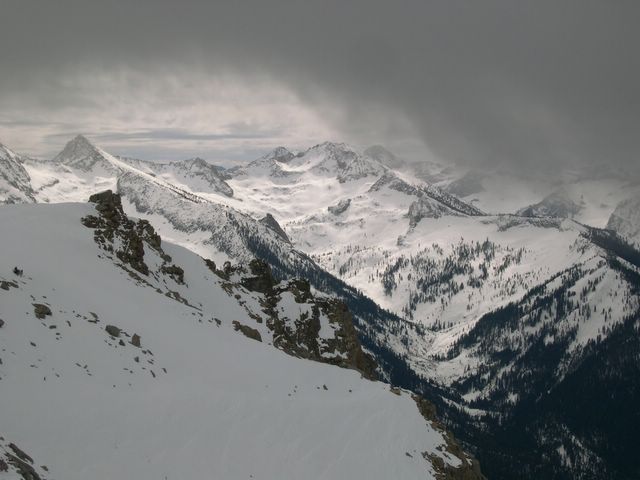 The next morning, Miles, Evan and Alisha left the hut to return to civilization. We still had one more day to rip it up. We set off again for Skier's Alta. This time, I pushed a bit harder and made it up in 1 hr 15 minutes. Sunday definitely wasn't as nice as Saturday. It was overcast and a bit cooler. But the snow was still great. We actually all got a decent sunburn on Saturday. SPF 15 just didn’t do the job. So it was probably for the best that it was cloudy. We spent most of the day hitting various chutes and doing our best to ensure that the next party at the hut wouldn't be able to find any untouched powder. We actually quit skiing around 3:30 that afternoon. I admit that I was the one who said that I didn't want to take another run…although I’m sure that if I had said I wanted to, the others would have resisted. So we went in and treated ourselves to some Gluhwein (hot wine with oranges, cinnamon and cloves). After a few glasses, we decided to go ski another run on the Front Yard (small hill right in front of the hut). I was in such a good mood that I was contemplating taking my headlamp out and going back to the top. Thankfully, I sobered up after a run on the Front Yard and decided that wouldn't be so wise. Instead, we treated ourselves to a round of beacon sniffing. That's where we hide an avalanche beacon and practice finding it using our own beacon. This was my first time using mine (Ortovox M1). It took a while before I remembered how it worked. I realized that I need to practice using it some more.
The next morning, Miles, Evan and Alisha left the hut to return to civilization. We still had one more day to rip it up. We set off again for Skier's Alta. This time, I pushed a bit harder and made it up in 1 hr 15 minutes. Sunday definitely wasn't as nice as Saturday. It was overcast and a bit cooler. But the snow was still great. We actually all got a decent sunburn on Saturday. SPF 15 just didn’t do the job. So it was probably for the best that it was cloudy. We spent most of the day hitting various chutes and doing our best to ensure that the next party at the hut wouldn't be able to find any untouched powder. We actually quit skiing around 3:30 that afternoon. I admit that I was the one who said that I didn't want to take another run…although I’m sure that if I had said I wanted to, the others would have resisted. So we went in and treated ourselves to some Gluhwein (hot wine with oranges, cinnamon and cloves). After a few glasses, we decided to go ski another run on the Front Yard (small hill right in front of the hut). I was in such a good mood that I was contemplating taking my headlamp out and going back to the top. Thankfully, I sobered up after a run on the Front Yard and decided that wouldn't be so wise. Instead, we treated ourselves to a round of beacon sniffing. That's where we hide an avalanche beacon and practice finding it using our own beacon. This was my first time using mine (Ortovox M1). It took a while before I remembered how it worked. I realized that I need to practice using it some more.

I must admit that my only regret for the trip was that my friend Carl couldn't make it. The previous Monday, he was the victim of a road rage incident. I'm not sure of all the details. He didn't want to tell me. All, I know is that a crazy Armenian guy (now in the custody of the LAPD) did some serious damage to his face. Despite the fact that Carl wasn't physically there, he was definitely there in spirit. Trying to discourage any of the girls from joining us on the trip, he was kind enough to make them absolutely paranoid that an avalanche was going to kill us all at any moment. Thank you Carl! I found it especially ironic since Carl was the one who told me that the Sierra snow pack is incredibly stable and that you really don’t need to wear an avalanche beacon more than a day after a storm. (Note: I'm by no means advocating that avalanche safety isn't important. He just had them convinced that the hut was as dangerous as a 35 degree slope the day after a 2 foot dump.) Another funny Carl story that came up was his trip into the hut last year with Nellie. Apparently they decided to do a moonlight headlamp trip into the hut on a Friday night. What could go wrong did go wrong. They got lost a few times and it ended up taking them close to 5 hours just to reach the top of the hump. Apparently when they got down to Pear Lake (~5 AM), Carl was delirious (from lack of sleep) and didn’t see where Nellie went when he was crossing Heather Lake. What he missed was that fact that Nellie avoided a weak spot in the ice. So when Carl went, he fell in up to his knees. It’s pretty funny now. But I’m sure Carl didn’t find it so funny back then. Enough with Carl and on to the rest of our story.
The next morning when we woke up it was raining. Yes...raining. The day before, we had heard that a storm was coming in and the snowline was supposed to be 8,000 ft. With the hut being at 9,200 ft, we thought we'd be fine. Despite the fact that it briefly shifted to snow after we left the hut, most of our descent was through the rain. It took us about 1.5 hours to make it back to the top of the hump and another hour to make it down. Once we got to where the Pear Lake Trail me the Panther Gap trail, I was amazed by how much the snow had melted. Countless rocks and logs that were once snow covered, now blocked the trail. The moss on the trees was now a bright green. It looked as if spring was on its way. All in all, my first Pear Lake trip was another great ski experience. I look for to joining Chris, Nellie, Tyler, Dianna, Dave, King, Miles, and Nat again next year. Lastly a big congrats to all the girls who joined us on the trip. Despite Carl's best efforts, they were real troopers and did great. In my book, they have all earned the right to assume the title, "hardcore skier chick."
Note: If you didn't already realize it from everything that followed the opening paragraph, the Pear Lake Hut is not in fact a terrible place. I just promised everyone that I would spread some negative press about it to keep it from getting too popular.









